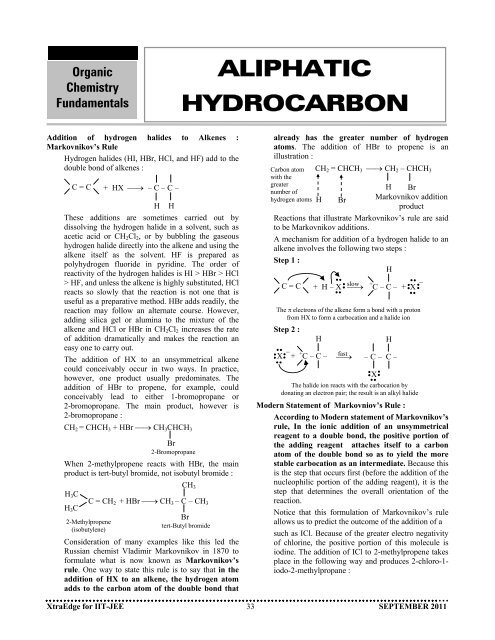September 2011 - Career Point
September 2011 - Career Point
September 2011 - Career Point
- No tags were found...
You also want an ePaper? Increase the reach of your titles
YUMPU automatically turns print PDFs into web optimized ePapers that Google loves.
OrganicChemistryFundamentalsALIPHATICHYDROCARBONAddition of hydrogen halides to Alkenes :Markovnikov’s RuleHydrogen halides (HI, HBr, HCl, and HF) add to thedouble bond of alkenes :C = C + HX ⎯→ – C – C –H HThese additions are sometimes carried out bydissolving the hydrogen halide in a solvent, such asacetic acid or CH 2 Cl 2 , or by bubbling the gaseoushydrogen halide directly into the alkene and using thealkene itself as the solvent. HF is prepared aspolyhydrogen fluoride in pyridine. The order ofreactivity of the hydrogen halides is HI > HBr > HCl> HF, and unless the alkene is highly substituted, HClreacts so slowly that the reaction is not one that isuseful as a preparative method. HBr adds readily, thereaction may follow an alternate course. However,adding silica gel or alumina to the mixture of thealkene and HCl or HBr in CH 2 Cl 2 increases the rateof addition dramatically and makes the reaction aneasy one to carry out.The addition of HX to an unsymmetrical alkenecould conceivably occur in two ways. In practice,however, one product usually predominates. Theaddition of HBr to propene, for example, couldconceivably lead to either 1-bromopropane or2-bromopropane. The main product, however is2-bromopropane :CH 2 = CHCH 3 + HBr ⎯→ CH 3 CHCH 3Br2-BromopropaneWhen 2-methylpropene reacts with HBr, the mainproduct is tert-butyl bromide, not isobutyl bromide :H 3 CH 3 CCH 3C = CH 2 + HBr ⎯→ CH 3 – C – CH 32-Methylpropene(isobutylene)Brtert-Butyl bromideConsideration of many examples like this led theRussian chemist Vladimir Markovnikov in 1870 toformulate what is now known as Markovnikov’srule. One way to state this rule is to say that in theaddition of HX to an alkene, the hydrogen atomadds to the carbon atom of the double bond thatalready has the greater number of hydrogenatoms. The addition of HBr to propene is anillustration :Carbon atomwith thegreaternumber ofhydrogen atomsCH 2 = CHCH 3 ⎯→ CH 2 – CHCH 3HBrH BrMarkovnikov additionproductReactions that illustrate Markovnikov’s rule are saidto be Markovnikov additions.A mechanism for addition of a hydrogen halide to analkene involves the following two steps :Step 1 :HC = Cslow+ H – X ⎯→+ –C – C – + XThe π electrons of the alkene form a bond with a protonfrom HX to form a carbocation and a halide ionStep 2 :HH–X + + C – C – fast⎯→ – C – C –The halide ion reacts with the carbocation bydonating an electron pair; the result is an alkyl halideModern Statement of Markovniov’s Rule :According to Modern statement of Markovnikov’srule, In the ionic addition of an unsymmetricalreagent to a double bond, the positive portion ofthe adding reagent attaches itself to a carbonatom of the double bond so as to yield the morestable carbocation as an intermediate. Because thisis the step that occurs first (before the addition of thenucleophilic portion of the adding reagent), it is thestep that determines the overall orientation of thereaction.Notice that this formulation of Markovnikov’s ruleallows us to predict the outcome of the addition of asuch as ICl. Because of the greater electro negativityof chlorine, the positive portion of this molecule isiodine. The addition of ICl to 2-methylpropene takesplace in the following way and produces 2-chloro-1-iodo-2-methylpropane :XXtraEdge for IIT-JEE 33 SEPTEMBER <strong>2011</strong>

















